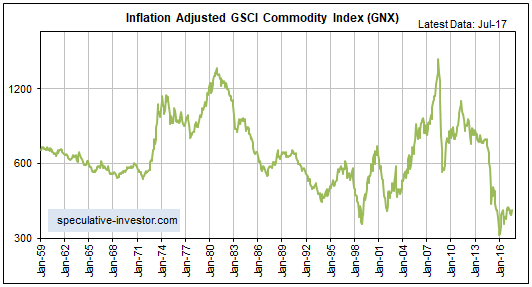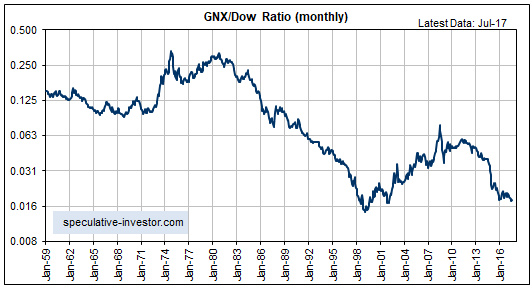[The following is an excerpt from a TSI commentary published about one month ago, but with updated charts.]
Some commentators on the financial markets still refer to something called the “commodity supercycle”. This is remarkable considering that the inflation-adjusted (IA) GSCI Commodity Index (GNX) made a new all-time low early last year and that relative to the Dow Industrials Index the GNX is not far from the all-time low reached in 1999. The relevant charts are displayed below. Just how badly would commodities have to perform to completely bust the supercycle myth?
We’ve been debunking the “commodity supercycle” in TSI commentaries for at least 10 years. The following lengthy excerpt from an August-2007 commentary is an example:
“…when it comes to the “commodity supercycle” we are definitely sceptics. We concur with the view that commodity prices in general and metal prices in particular are in long-term upward trends, but we do not think these trends are being driven by the strong growth of “Chindia” or the global spread of capitalism or the industrialisation of Asia or the movement of billions of people to the ranks of the “middle class” or any of the other catchphrases routinely used to neatly explain the price action. In our opinion, these explanations rank alongside slogans such as “new economy” and “technology-driven productivity miracle” that were used to legitimise the price action of tech stocks during the boom of the late-1990s.
As we see it, inflation (money supply growth) is causing a rolling boom/bust cycle whereby the combination of relative valuation and scarcity determines which sectors will be the major beneficiaries of inflation during the current cycle and which sectors will be relegated to the investment ‘scrap heap’.
The analysts who concoct simple explanations based on real (non-monetary) changes in the world and repeat these explanations in mantra-like fashion will look incredibly prescient for a long time, even though they largely ignore the monetary factors that are actually at the root of the price changes. Some of these analysts will even take-on the status of prophets due to their apparent abilities to see the future. But the inflation-fueled boom will eventually turn into a bust, even if the touted fundamental bases for the boom persist. For example, the growth of the internet and technological progress in general did not ‘miss a beat’ when the NASDAQ crashed. All that happened was that the primary focus of inflation shifted, causing the “new economy” prophets to fade away and bringing to the fore a new bunch of prophets who chant “commodity supercycle”.”
The above three paragraphs can be summarised as: There never has been and there is never likely to be a “commodity supercycle”. Instead, during some periods financial assets are the main beneficiaries of monetary inflation and during other periods commodities are among the main beneficiaries of monetary inflation.
It’s as simple as that.
The periods when financial assets are the main beneficiaries of monetary inflation are, on average, much longer than the periods when commodities are among the main beneficiaries of monetary inflation. This is because central bankers generally view large multi-year rises in commodity prices as evidence of an inflation problem and large multi-year rises in financial-asset prices as evidence that everything is fine. Consequently, steps are taken to curtail the monetary inflation more quickly when commodity prices are leading the charge.
The situation today presents an asset-allocation challenge because it’s far too soon for a new long-term commodity boom to get underway, but the major financial assets (stocks and bonds) are near their highest valuations ever. We are dealing with this situation by becoming more short-term-oriented in our thinking, which for us means not looking beyond the next 6-12 months when deciding what to own.
 Print This Post
Print This Post


